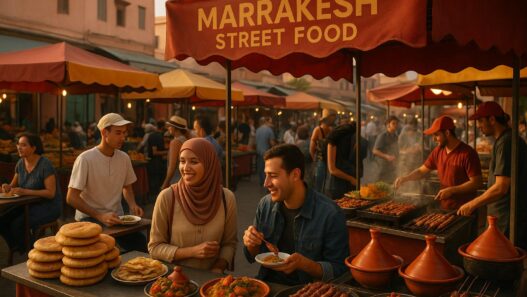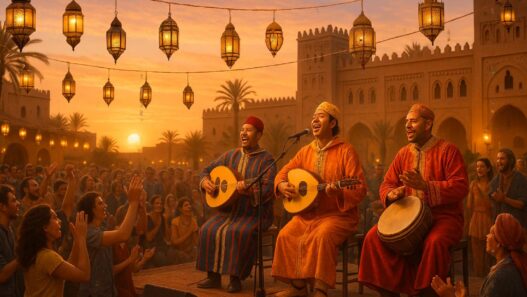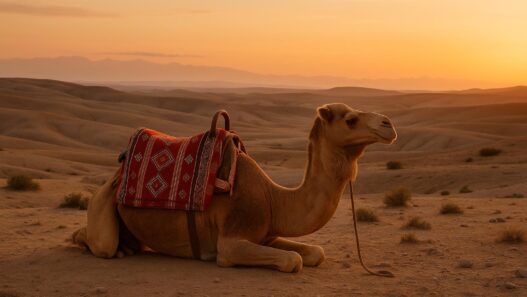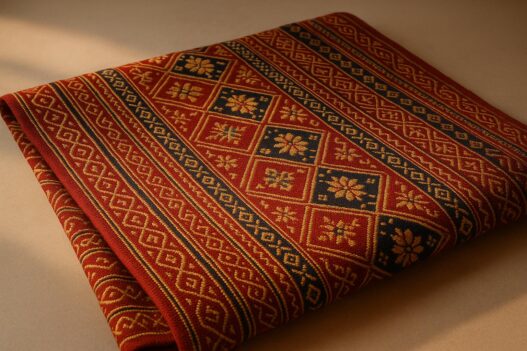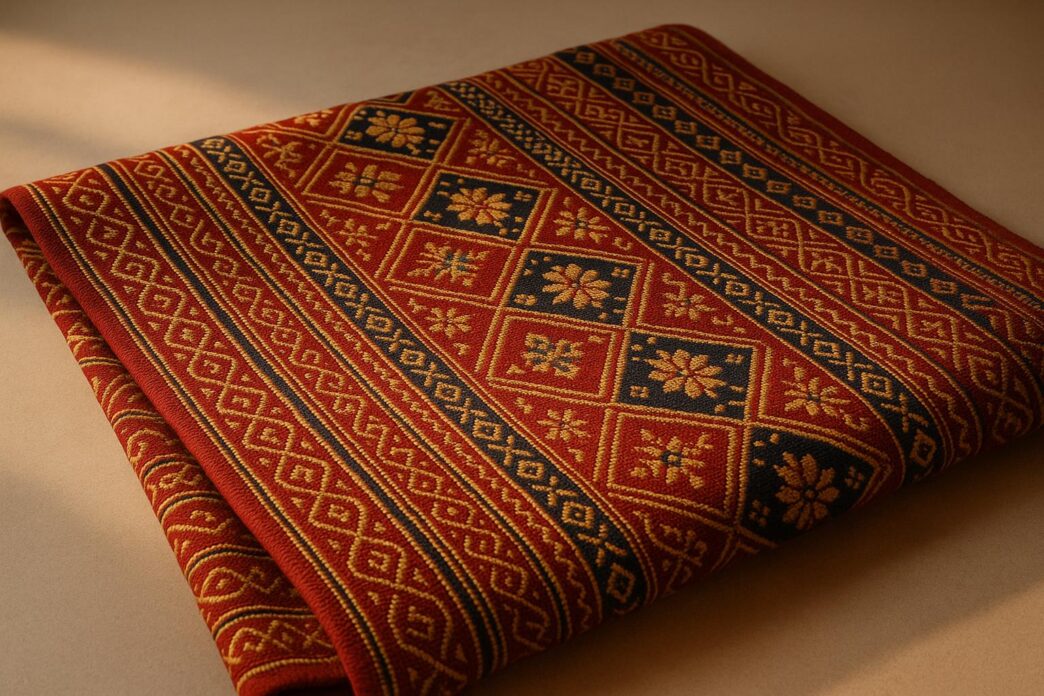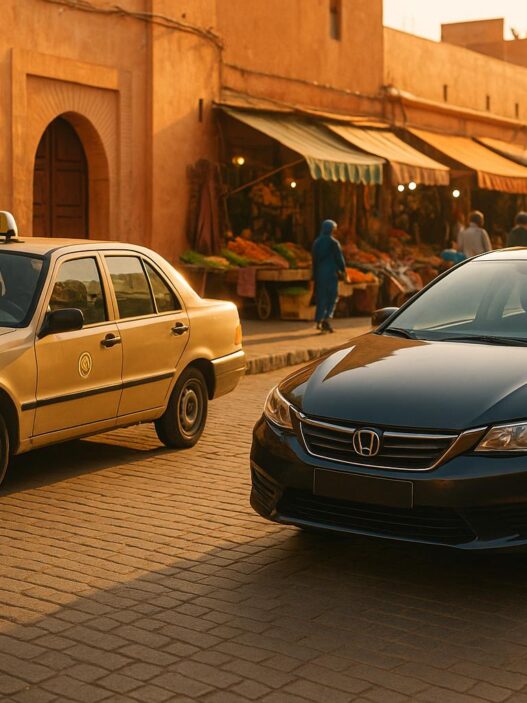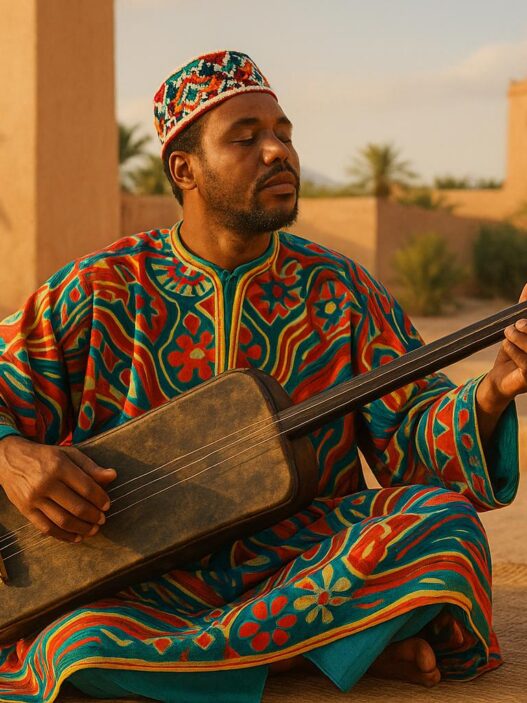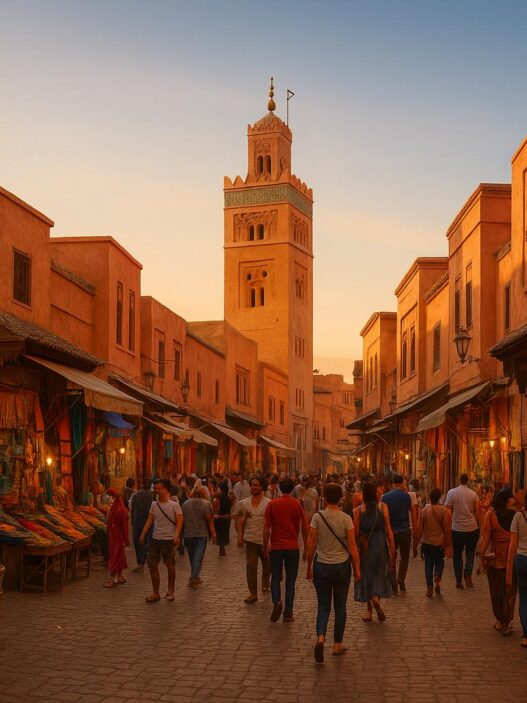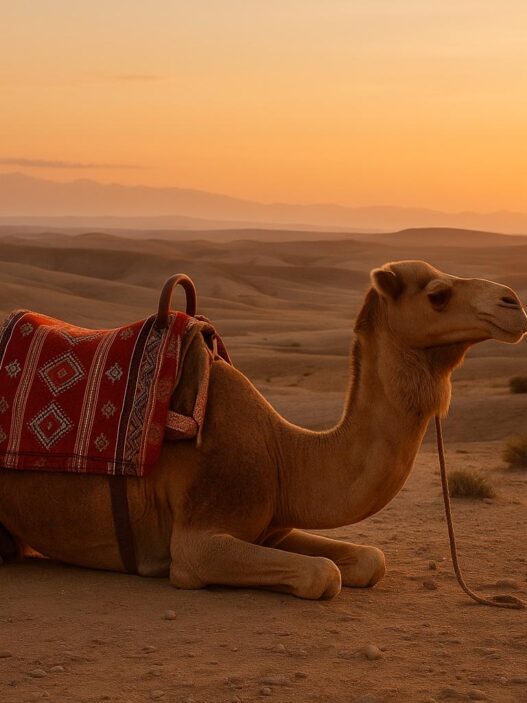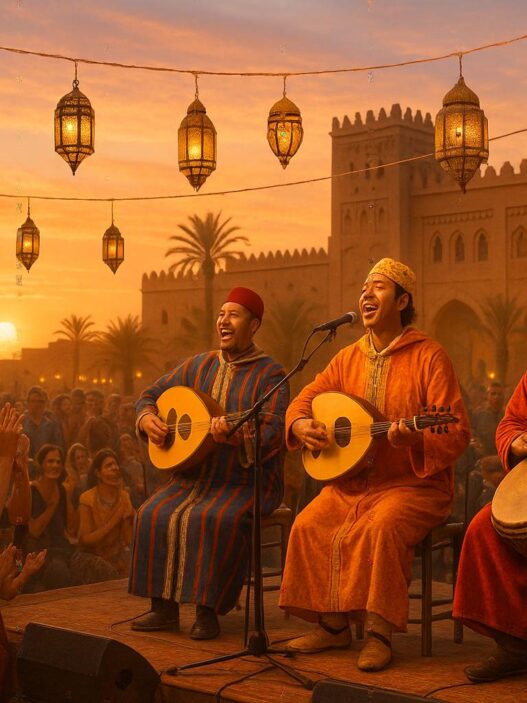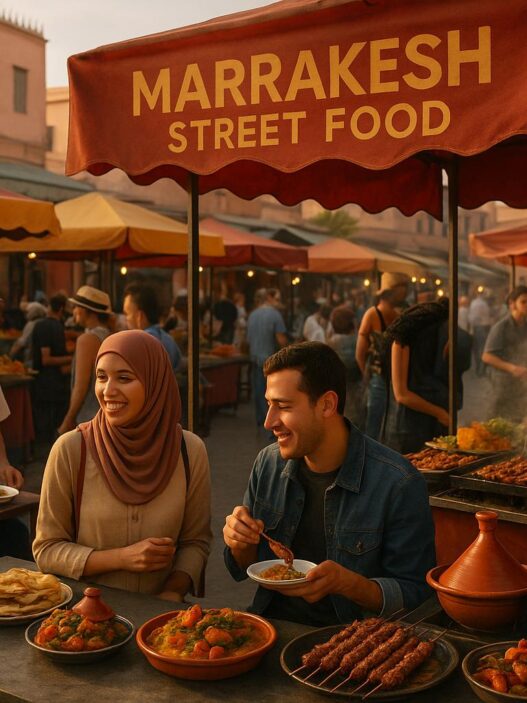Moroccan textiles are more than just decorative pieces – they’re visual stories woven with symbolic meanings that reflect the country’s history, beliefs, and way of life. From protection symbols to representations of nature and family, each pattern carries a unique message. Here’s a quick breakdown of the key patterns and their meanings:
- Diamond Motif: Represents protection, femininity, and fertility, often symbolizing the womb and generational continuity.
- Zigzag Pattern: Depicts water’s flow and life’s unpredictable journey, emphasizing resilience and survival.
- Cross and X Motifs: Symbolize balance, spiritual protection, and unity, often tied to feminine energy.
- Lines and Borders: Represent pathways, transitions, and life’s journey, framing the textile’s story.
- Triangles: Stand for growth, family, and fertility, often linked to motherhood and unity.
- Eye Motif: Acts as a guard against the evil eye, offering spiritual protection.
- Checkerboard and Grid: Reflect community, order, and connection to the land.
- Stars and Rosettes: Represent spirituality, guidance, and hope, blending Islamic and Amazigh influences.
- Hands of Fatima (Khamsa): A talisman for blessings, safety, and good fortune.
- Animal and Plant Motifs: Highlight nature, prosperity, and transformation, with symbols like birds, fish, and the Tree of Life.
Each region in Morocco adds its own interpretation and style to these patterns, making them rich in diversity and meaning. Whether you’re admiring a Berber rug or a ceremonial garment, understanding these motifs deepens your appreciation of the artistry and storytelling behind Moroccan textiles.
Women Artisans of Morocco
1. Diamond Motif: Protection and Femininity
The diamond pattern, also known as the lozenge, is one of Morocco’s most powerful and meaningful textile symbols. Found in traditional wool and silk textiles, these sharp, symmetrical shapes carry a rich heritage and profound symbolism.
Experts have extensively documented the importance of this motif in Moroccan textiles:
"The main female symbols in Berber carpets are the lozenge, the chevron, and the X-shape." – Maroc Tribal’s Journal
Far from being just decorative, the diamond motif represents deep feminine energy and reflects ancient Amazigh beliefs tied to womanhood and fertility. Its enclosed, balanced form is often seen as a prayer for fertility and a protective emblem. The design recalls ancient rock carvings and symbolizes the life-giving power of the womb.
When smaller diamonds are nested within larger ones, the meaning becomes even more profound. This arrangement evokes the image of a child within the womb, symbolizing generational continuity, family lineage, and the hope for abundant offspring.
The interpretation of the diamond motif varies across Morocco’s regions. Beni Ourain rugs, for instance, often feature bold, geometric diamonds on an ivory background, radiating a sense of simplicity and strength. Meanwhile, Azilal and Boujad rugs bring their own vibrant and colorful expressions to the motif.
In many Moroccan communities, diamond patterns are woven into wedding textiles and baby blankets. These designs are believed to bring blessings of fertility, ensure safe childbirth, and strengthen family bonds for generations to come.
2. Zigzag Pattern: Water and Life’s Journey
The zigzag pattern carries a deep meaning, symbolizing the essential flow of water and life’s unpredictable path, both of which highlight the resilience and strength of Berber culture.
Water plays a central role in this motif. The zigzag lines resemble flowing water and the life-giving rain that sustains communities in Morocco’s dry landscapes. In regions like the Atlas Mountains, where water is often scarce, these designs serve as a reminder of its critical role in survival.
As Asala Living explains:
"Zigzag patterns represent water and fertility, highlighting its importance in the arid Atlas Mountains." – Asala Living, March 18, 2025
This motif brings together the natural necessity of water with the human spirit of perseverance.
The zigzag also reflects life’s journey. According to Moroccartisans:
"Zigzag patterns represent the journey of life, with its ups and downs, a theme that resonates across Berber culture." – Moroccartisans
Regional differences add even more depth to this design. In the High Atlas, artisans often use bold zigzag patterns in saffron and indigo, colors that mirror the dramatic hues of their rugged environment. In the Middle Atlas, the zigzags evoke the sharp peaks of the mountains, while coastal artisans incorporate fishbone-like designs inspired by the sea.
Skilled weavers often combine traditional weaving techniques with embroidery to craft intricate zigzag patterns. These designs are frequently paired with straight lines that symbolize rain, representing fertility and growth. The geometric precision of the motif allows artisans to add personal touches while preserving its timeless essence.
In March 2025, Asala Living highlighted how Beni Ourain carpets feature zigzag patterns that emphasize themes of water and fertility, reflecting the resilience needed for survival in the Atlas Mountains.
The dynamic zigzag pattern, echoing the flow of water and the rhythm of life’s passage, brings energy to textiles used in everyday rituals and special ceremonies.
3. Cross and X Motifs: Balance and Spiritual Protection
In Moroccan textiles, the cross and X motifs carry deep spiritual meaning, rooted in ancient Berber traditions.
The X motif, in particular, is rich with symbolism. It represents feminine energy, fertility, and the interconnectedness of life – bringing together opposites like man and woman, earth and sky, and even past and future. For master weavers, the X is more than a pattern; it’s a reflection of harmony and unity, blending dualities into a cohesive whole. This balance naturally lends itself to protective qualities within the designs.
Cross patterns, on the other hand, are believed to ward off the evil eye and negative energies. They also symbolize the four cardinal directions, offering a sense of orientation and harmony with nature. When pairs of X motifs are woven together, they are seen as a representation of two souls coming together in union.
"Each ‘X’ is a meeting. It is where two paths cross and never separate." – Master weaver from Khenifra
These motifs are not merely decorative; they are deeply personal. The X often serves as the weaver’s mark, a subtle blessing infused into the textile. A field of X motifs transforms the piece into a prayer for peace and protection, giving the work a spiritual depth that transcends its physical form.
Interestingly, the influence of these designs extends far beyond Morocco. They’ve inspired modern architects and designers worldwide, who incorporate these traditional patterns into contemporary works, blending the old with the new.
Every thread in these textiles tells a story of balance and protection. It’s not just about creating a beautiful piece – it’s about weaving a legacy, a spiritual connection that ties Morocco’s rich cultural traditions to the present day and beyond.
4. Lines and Borders: Pathways and Transitions
Building on themes of protection and journey, lines in Moroccan textiles add another layer of symbolic meaning. They transform fabric into a visual story, mapping life’s experiences and transitions.
In Berber weaving, a long, continuous line often represents the journey of a family. Broken lines, on the other hand, suggest moments of disruption or change, while intersecting lines symbolize relationships or new paths taken.
Borders play an equally important role, framing the textile’s story while acting as a protective boundary. These borders can range from intricate, heavily detailed patterns to simple, understated designs that draw attention to the central narrative. A well-defined border holds the textile’s purpose intact, creating a sacred space that remains distinct from the outside world.
For the Amazigh, weaving was not just about creating warmth – it was a way to mark time and encode prayers, blessings, and themes of birth and fertility into the fabric.
Understanding these patterns shifts how we perceive Moroccan textiles. What might seem like decorative details are, in fact, complex communication systems, preserving stories and ancestral wisdom for future generations. These symbolic threads invite deeper exploration into the rich language of Moroccan textile art.
5. Triangles: Growth and Family
In Moroccan textile art, the triangle is a powerful symbol of generational unity. It represents fertility, womanhood, and the bonds that tie families together. Whether displayed alone or in clusters, triangular patterns can convey ideas of motherhood, the continuation of family traditions, or the growth of a lineage over time.
Different regions add their own interpretations to these symbols. For example, the Zemmour tribe from the Middle Atlas incorporates unique triangular designs into their pillows and textiles. These patterns, often referred to as "arrows", are said to symbolize cosmic energy, male vitality, and fertility.
Triangles also carry meanings that go beyond family. In Amazigh culture, they are seen as representations of strength and dignity. They can also reflect Morocco’s natural landscape, evoking images of its rugged mountains.
The triangular motifs found in Moroccan textiles are more than decorative – they are a way of preserving cultural identity. As Ihssan, an Amazigh carpet salesman, puts it:
"The Berber culture is very deep, very mysterious, and it is very rich".
This richness is evident in how these patterns continue to embody ancient ideas about family, growth, and the sacred connections that unite communities across generations.
6. Eye Motif: Warding off the Evil Eye
The eye motif holds a strong protective role in Moroccan textiles, serving as a guard against the evil eye, known as l’ayn in Arabic.
As Edvard Westermarck, a scholar of Moroccan beliefs, explains:
"Besides the fingers of the hand, there is another means of throwing back the baneful power, l-bas, which emanates from an evil eye, namely, the image of an eye. If baneful energy can be transferred by the eye, it can obviously also be thrown back by the eye. The image of an eye, or a pair of eyes, is therefore very commonly used as a charm."
The concept of the evil eye has deep historical roots in Morocco. Evidence from Spanish cave drawings and Syrian amulets shows that this belief dates back thousands of years.
Over time, the eye motif has evolved into various forms in Moroccan textiles. It can appear as triangles, diamonds, oblong shapes, or dots within diamonds. Some researchers suggest that many geometric designs – like squares, zigzags, crescents, and stars – are stylized representations of eyes. The symbol often merges with the khamsa (the Hand of Fatima), creating a dual layer of protection. For instance, in Fes, you’ll find stylized khamsa designs on door nameplates, while hennaed drums frequently feature the eye-in-a-hand motif.
The evil eye’s influence spans both Jewish and Muslim traditions, with proverbs in both communities highlighting its role as a source of misfortune. Graduate student Noam Sienna from the University of Minnesota explains the protective essence of the motif:
"The symbolic idea is that the eye looks back and breaks the stare of the Evil Eye."
Today, the eye motif is not limited to textiles; it also appears in jewelry, ceramics, and amulets. Its enduring presence is even evident in modern Moroccan henna art, where realistic eye designs have gained popularity. This motif continues to bridge the gap between ancient spiritual beliefs and contemporary artistic expression, showcasing Morocco’s ability to blend tradition with creativity.
sbb-itb-fa26f1f
7. Checkerboard and Grid Patterns: Community and Order
Moroccan textiles often draw upon geometric designs to convey deeper meanings, and checkerboard and grid patterns are no exception. These designs, with their neatly arranged squares and intersecting lines, represent both community and order. They visually echo the balanced and cooperative structures found in traditional Moroccan societies, weaving a sense of shared heritage into every thread.
In Berber textiles, squares hold a special meaning. They are seen as symbols of order and a profound connection to the land. As BerberCreations.com explains, "The square symbolizes order and connection to the land, reflecting the culture of unity". Beyond this, the squares in Berber rugs carry personal significance as well. For example, they often indicate that the weaver is unmarried, with the design process representing her navigation through life’s complexities and responsibilities.
These patterns frequently appear in communal and ceremonial fabrics, where their symbolism becomes even more pronounced. The intricate construction of checkerboard motifs in Berber rugs requires not just creativity but also a deep understanding of geometry and mathematics. This precision mirrors the careful planning and cooperation that underpin Moroccan communal life.
Checkerboard and grid patterns are not confined to textiles – they also feature prominently in Moroccan architecture, showcasing their enduring relevance. Rebecca Proctor highlights their timeless appeal:
"Checks have been revered as something high and important in design forever… What’s so fun about design is reviving things and bringing them back to give them new views, new lives, new meaning, and new references".
During cultural celebrations like Ramadan and weddings, these patterns take on a vibrant role. Dresses adorned with checkerboard and grid motifs become a way to express both personal heritage and collective identity. Each carefully crafted design reflects the harmony and unity that emerge when individual elements come together, creating a story of connection and shared beauty.
8. Stars and Rosettes: Spirituality and Guidance
Stars and rosettes hold profound spiritual significance in Moroccan textiles, weaving together deep-rooted beliefs and artistic expression. These motifs are prominently featured in traditional clothing, such as kaftans and ceremonial robes, where they serve as symbols of guidance and protection. Their presence reflects a seamless blend of creativity and spirituality.
In Moroccan kaftans, star patterns are often associated with fortune and safeguarding, showcasing the artisans’ spiritual connections and intentions.
Rosettes, with their circular and flower-like designs, add another layer of meaning, symbolizing spirituality and inner resilience. These motifs have also influenced the evolution of Islamic art, inspiring increasingly intricate designs over time.
The development of celestial patterns in Islamic art underscores their enduring importance. For example, star motifs evolved from simple forms in the 9th century to intricate 14- and 16-point stars by the 16th century. A standout example is the eight-pointed star, a recurring feature in Islamic tilework. This design is created by overlaying two squares, one rotated 45 degrees relative to the other. Such geometric patterns are often seen as a spiritual bridge, purifying both the mind and soul.
In Amazigh traditions, stars symbolize hope and divine guidance, adding another layer of meaning to these motifs. This indigenous perspective complements Islamic interpretations, showcasing the diverse spiritual influences that shape Moroccan textiles.
Additionally, the geometric patterns found in kaftans echo elements of Moroccan architecture, reinforcing the sense of spiritual balance and harmony. Together, these motifs reveal the intricate relationship between belief and artistry in Moroccan culture.
9. Hands of Fatima (Khamsa): Blessings and Safety
Moroccan textiles are steeped in rich symbolism, and the Hand of Fatima, or Khamsa, stands out as one of the most iconic motifs. More than just a decorative element, this ancient symbol serves as a talisman believed to bring protection, good fortune, and blessings. It has deep roots in Morocco’s cultural and spiritual traditions.
The name Khamsa comes from the Arabic word for "five", representing the five fingers of the hand. Each finger is said to embody qualities like strength, focus, unity, love, and faith. This symbol dates back to ancient Mesopotamia and is considered one of the oldest protective emblems. A common feature in many designs is the central eye, thought to ward off the "evil eye".
In recent years, Moroccartisans.com highlighted the intricate work of Fez artisans, who create silver Khamsa pendants adorned with filigree and turquoise stones. Many of these pendants are inscribed with words like baraka (blessing) or salam (peace), reflecting Morocco’s spiritual and artistic legacy. During the 19th century, Jewish silversmiths crafted similar talismans, often incorporating phoenix and salamander motifs to symbolize life, rebirth, and fertility .
Today, the Khamsa finds its way into a variety of modern designs, from wall hangings and pottery to jewelry and ceremonial clothing. This blending of tradition with modern aesthetics keeps the symbol relevant in contemporary Moroccan culture. It holds significance across multiple faiths, including Islam, Christianity, Judaism, and Hinduism, and plays a key role in cultural events like henna ceremonies, where it represents blessings, unity, and community bonds.
For travelers, Khamsa items are widely available and cater to different budgets. Small handmade metal wall hangings can be purchased for as little as $2.00, while intricate antique pieces may cost several hundred dollars.
10. Animal and Plant Motifs: Nature and Prosperity
Moroccan textiles are rich with animal and plant motifs, each carrying stories of Morocco’s landscapes and the traditions of the Berber people. These designs are more than decorative – they’re imbued with meaning, often serving as spiritual symbols passed down through generations. The natural imagery woven into these textiles reflects the deep cultural narratives of Morocco.
Birds, for example, are seen as symbols of fortune and joy. Fish motifs, on the other hand, are associated with abundance and the ability to thrive, making them popular in textiles meant to attract prosperity. Snakes are viewed as emblems of transformation and protection.
Camels, a vital part of life in Morocco’s arid regions, represent resilience and the ability to endure challenges. Even smaller creatures carry significance: frogs symbolize fertility due to their prolific reproduction, while fish skeletons are believed to ward off negative energy.
Plant motifs, particularly the Tree of Life, hold profound meaning, symbolizing progress, resilience, and a deep bond with nature. This ancient emblem appears in various forms, from simple branches to intricate tree designs. Smaller botanical elements like twigs echo this connection to nature, while floral patterns add layers of symbolism: orange blossoms signify purity, lilies represent innocence, and roses embody beauty. These floral designs often adorn ceremonial garments, marking life’s significant milestones.
Berber women, the primary weavers for generations, have preserved these traditions, passing their skills and knowledge from mother to daughter. This continuity ensures that Moroccan textiles remain cultural treasures, carrying the legacy of the Berber people.
Regional styles further enrich these motifs. Different parts of Morocco interpret symbols uniquely, influenced by local environments and customs. A bird motif from the Atlas Mountains might hold a slightly different meaning than one crafted in coastal areas, reflecting the diverse experiences of Morocco’s communities.
For those exploring Moroccan markets, understanding these symbols can transform the shopping experience. A textile featuring birds and fish isn’t just visually appealing – it’s a piece of art that symbolizes joy and abundance. Similarly, plant-based designs connect the owner to themes of resilience and growth, making these textiles meaningful additions to any home.
| Animal/Plant Motif | Primary Symbolism |
|---|---|
| Birds | Fortune and joy, bringing luck and happiness |
| Fish | Abundance and the ability to thrive |
| Snakes | Transformation and protection |
| Tree of Life | Progress and resilience, connection to nature |
| Camels | Resilience and endurance |
| Frogs | Fertility |
These nature-inspired designs highlight how Moroccan artisans draw from their surroundings to craft textiles that bridge the physical and spiritual worlds. They celebrate Morocco’s natural beauty while honoring the enduring relationship between its people and the land.
Pattern Comparison Table
Moroccan textiles are a vibrant tapestry of symbolism, tradition, and regional diversity. Each pattern tells a story, reflecting the heritage of the communities that craft them. Below is a table that highlights ten key patterns, their meanings, and how they are interpreted across Morocco’s regions.
| Pattern Name | Symbolic Meaning | Common Textile or Garment | Regional Significance |
|---|---|---|---|
| Diamond Motif | Represents protection, strength, clarity, and balance | Berber rugs, kaftans, wall hangings | Tribes in the Atlas Mountains use bold, large diamonds, while coastal areas favor intricate, smaller designs |
| Zigzag Pattern | Symbolizes water, life’s journey, and continuity | Djellabas, Berber rugs, door curtains | Northern regions emphasize water symbolism; southern areas focus on life’s journey |
| Cross and X Motifs | Reflects ancestral connection and spiritual guidance | Ceremonial kaftans, prayer rugs, wedding textiles | Fez artisans create precise geometric crosses, while Rabat showcases vibrant, bold designs |
| Lines and Borders | Signify pathways and transitions | Gandoura trims, rug borders, table linens | Warm yellows and oranges dominate in the south, whereas cooler blues and whites are preferred in the north |
| Triangles | Represents femininity, fertility, and protection | Women’s ceremonial dresses, wedding chest covers, mattress fronts | Tetouan embroidery features delicate triangles on mirror covers; Azemmour incorporates them into linen hangings |
| Eye Motif | Wards off the evil eye | Children’s clothing, babouches, protective amulets | Found across Morocco with variations in size and detailing |
| Checkerboard and Grid | Conveys order and mathematical precision | Cushion covers, table napkins, door curtains | Fez textiles reflect intricate zellij tilework, while Sale opts for simpler grids |
| Stars and Rosettes | Symbolize hope and divine guidance | Prayer textiles, ceremonial robes, wedding linens | Prominent in spiritual hubs like Fez |
| Hands of Fatima (Khamsa) | Represents blessings, safety, and craftsmanship | Protective garments, children’s clothing, household textiles | While the meaning stays consistent, artistic styles vary by tribal tradition |
| Animal and Plant Motifs | Reflect nature, prosperity, and transformation | Decorative rugs, ceremonial garments, home furnishings | Designs often mirror local environments – camels in desert areas, fish along the coast |
Moroccan textiles are deeply tied to their regions, with each area bringing its own flair. For instance, Fez embroidery often mimics the city’s iconic zellij tile patterns, while Rabat’s designs are known for their bold colors and lively character, reflecting the energy of the coastal city.
Beyond aesthetics, these patterns also serve functional roles. Chefchaouen is known for its arid, large cloths used as wall hangings or wedding chest covers. Tetouan embroidery, on the other hand, is celebrated for its use in soft furnishings and unique mirror covers called tenchifa, as well as clothing details like the tikka drawstring on women’s trousers.
The weaving techniques also vary widely between tribes and regions, ensuring that even common designs like diamonds and zigzags carry distinct local touches. This variety not only highlights the craftsmanship but also enhances the identity of each piece.
Understanding these regional nuances – like the difference between an Atlas Mountains diamond-patterned rug and its coastal counterpart – adds depth to the experience of exploring Moroccan textiles. It’s a journey through artistry, history, and culture, woven into every thread.
Conclusion
Exploring the cultural meanings behind Moroccan textile patterns transforms shopping into much more than a transaction – it becomes a journey through history and tradition. Recognizing a diamond as a symbol of protection or a zigzag as life’s winding path connects you with the artistry and storytelling embedded in these designs. This knowledge is especially valuable when wandering through Marrakesh’s lively souks, where every turn offers a new discovery.
By understanding the craftsmanship behind each piece, you can make thoughtful purchasing choices and fully immerse yourself in the rich heritage of Moroccan textiles. Supporting local artisans not only helps preserve this timeless art form but also allows you to bring home pieces imbued with spiritual significance, believed to ward off negativity and invite good fortune.
From the intricate geometry of Fez embroidery to the bold, coastal-inspired patterns of Rabat, these ten key motifs add depth and meaning to every market visit. The next time you examine a Berber rug or admire a kaftan adorned with symbolic designs, you’ll uncover the cultural narratives woven into every thread. Let this knowledge guide and enrich your experience as you explore and acquire authentic Moroccan textiles.
For more tips on navigating Marrakesh’s artisan markets, shopping advice, and cultural insights to enhance your adventures, visit The Marrakesher, a resource designed with English-speaking travelers in mind.
FAQs
How do different regions in Morocco shape the meaning of textile patterns?
Moroccan textile patterns are a vivid reflection of the country’s regional and tribal traditions, with each area bringing its own flair. In the northern regions, cool tones like blue and white dominate, symbolizing peace and spirituality. Meanwhile, the southern areas lean toward warm hues such as yellow and red, which stand for strength and courage. These color choices are deeply tied to the local environment, beliefs, and the social identity of the people.
The motifs and colors unique to each region are more than just decorative – they tell stories steeped in history and meaning. Moroccan textiles are not only visually stunning but also serve as a window into the nation’s rich and varied heritage.
What is the cultural significance of Moroccan textiles in traditional events?
Moroccan textiles carry profound meaning, symbolizing identity, heritage, and even social standing. These vibrant fabrics play a central role in significant life events such as weddings, religious ceremonies, and festivals. Whether it’s a bridal shawl draped with care or a protective amulet woven with intention, each piece tells a story. The intricate patterns and carefully chosen materials reflect Morocco’s deep historical roots and the exceptional artistry of its craftspeople, making these textiles a cornerstone of both personal and shared traditions.
How does understanding Moroccan textile patterns make shopping in local markets more meaningful?
Understanding the rich meanings woven into Moroccan textile patterns can completely change how you view your purchases. Many of these designs carry profound symbolism, representing themes like protection, fertility, or spiritual beliefs, all deeply tied to Morocco’s cultural heritage.
When you recognize these motifs, you’re not just buying a piece of fabric – you’re connecting with the stories and traditions of the artisans who created it. It adds a layer of depth and meaning to your shopping experience, making each item feel like a personal link to the culture. Whether you’re wandering through lively souks or browsing boutique shops, knowing the significance of these patterns brings more value and appreciation to your keepsakes.



